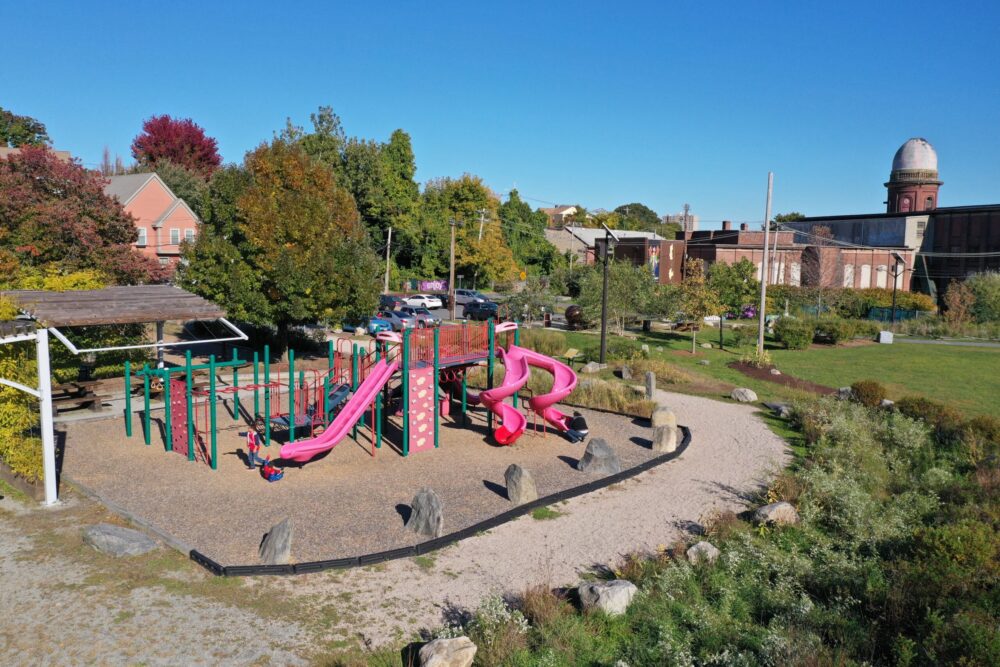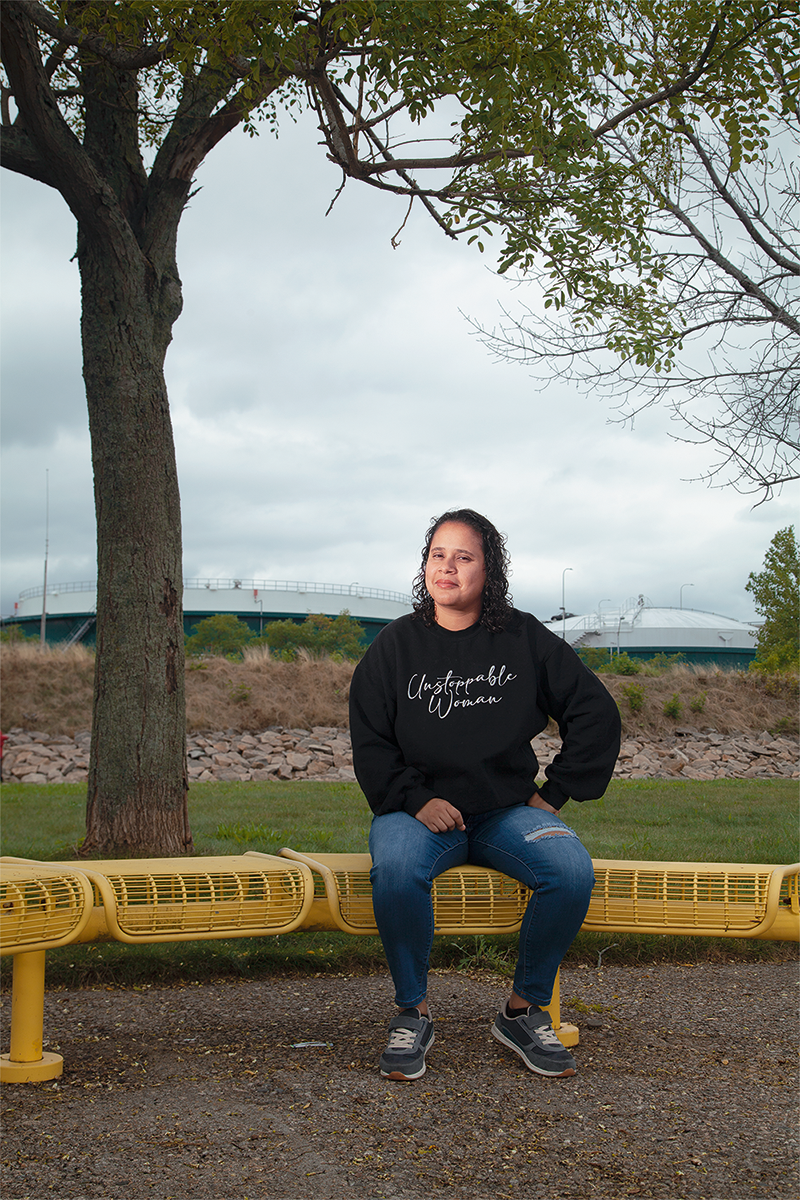Taking Root
Environmental Activists Grow Local Efforts
By Amanda ValentineRiverside Park sits as a jewel of a park along the Woony River Greenway in Olneyville. Where once lay decay after the area declined in World War II, now sits one of the best hidden gems of the Providence Parks system. Title image courtesy of Woonasquatucket River Watershed Council.
UP THROUGH THE 1800s, a cotton and textile manufacturing factory known as Riverside Mills operated on the Woonasquatucket River in the Olneyville neighborhood of Providence.
As the Industrial Revolution slowed, so did business, and the owner filed for bankruptcy and sold the once-bustling 11-building complex by the end of the century. The site devolved into an unusable brownfield by the early 20th century, and in 1989, a fire burned the remaining buildings and rendered the area a dumping ground.
Thirty years later, the field is now Riverside Park, and it hosts a sizable playground, a stage, a fish ladder exhibit, and plenty of open space for families to picnic or play. It is what residents of Olneyville requested when the Woonasquatucket Greenway Project—now Woonasquatucket River Watershed Council (WRWC)—came to them and asked what they wanted to see in their community.
Built not just for the community, but by the community, the park underlines the lasting effectiveness of community-driven environmentalism. The park maintains the tradition of community involvement on which it was built by providing upcoming generations of kids with opportunities for hands-on experience.
Nadia Grisaru, who worked with WRWC as a TerraCorps volunteer and youth education and community engagement coordinator, spent the last year helping kids at the Met School foster an appreciation for the environment and connect with nature in ways unique to them.
The Met School, which comprises six public high schools across Rhode Island, builds its curriculum around internships and long-term projects that are tailored to each student’s specific interests. Grisaru’s job was to help 10th grade students earn their science credit through a year-long research project that builds a connection between their specialized interests and the environment.

Playground at Riverside Park.
For younger grade levels, engagement might look like raising native trout in the classroom and releasing them into the Woonasquatucket at the end of the year, or making their own paper on which to write letters to the river. For all ages, Riverside Park and its array of educational and interactive signage is a frequent destination for field trips.
“We’re more just trying to get the students to have fun outside and being along the river,” explains Grisaru, “and kind of learn about some of the environmental issues related to the river, but in a very kind of hands-on, place-based way.”
Grisaru’s involvement in activism began in high school when an independent study with a teacher who had been an activist and written several books on environmental justice inspired Grisaru, who uses she/they pronouns, to pursue environmentalism outside of research.
“That was kind of a place where I was realizing that there needs to be a much broader effort to tackle climate change and kind of correct and help fix some of these systemic issues and injustices that happen,” she recalls. “The environment is connected to all these other forms of injustice, and everything is really intertwined.”
The Port of Providence is an illustrative case–it is located in the most diverse county in Rhode Island with the lowest income per capita, and its history of industrialization means residents face a variety of environmental hazards.
Of these, air pollution is among the most critical: the Rhode Island Department of Health’s Asthma State Plan cites environmental triggers as a significant contributor to the state’s asthma rates, which are well above the national average.
Within the state, those most vulnerable to air toxics and respiratory hazards, and most likely to make an emergency department visit for asthma, live in or closest to the Providence area.
Frustrated with a lack of progress in addressing these issues, a growing number of residents near the port are demanding environmental justice.
A liquified natural gas facility was proposed for the Port of Providence in 2015. Fearing environmental health risks, Monica Huertas, who has been a resident of the city for 28 years, and a group of other Providence residents began a “No LNG in PVD” campaign.
Though the facility was eventually approved, the grassroots effort survived and grew into the People’s Port Authority, a nonprofit organization seeking community oversight regarding fuel and gas companies in the Port of Providence.
They succeeded by “regular old door knocking and telling people what’s going on and having them come out to meetings and tell their stories,” explains Huertas. “Having activities that engages them and engages their children, that’s it.”
Huertas is a mother of four children—an immense responsibility that has not taken away from her position as director of the People’s Port Authority, but instead guided it.
“Being able to show up to the hearings, as a mother of four, where do you bring the kids, you know, where’s the childcare?” says Huertas. “So, I’ve been able to set up these things so that anybody can participate, but it has been tremendously difficult to do that.”
Globally and historically, despite often having to balance the demands of motherhood and family care, women have been disproportionately affected by environmental injustice.
I’m literally fighting for my kids’ life and for my neighbors.

Monica Huertas, executive director of the People’s Port Authority, works to ensure anyone in her community can participate in advocating for environmental justice. Portrait by Dana Smith.
According to a 2021 report by the Organization for Economic Cooperation and Development, 75% of the millions of people vulnerable to displacement by climate change are women.
Additionally, the 2011 United Nations Development Programme’s Human Development Report found that areas of high gender inequality correlate to areas of high environmental degradation. Defending themselves, their kids, and their communities, women have been the preeminent catalysts and leaders of environmental grassroots movements for decades.
“Women have always been involved in every single thing, especially women of color, especially Black women,” says Huertas. “The people involved in the organization are … women of color, women who understand it at a deeper level than anybody, you know, than other people who don’t have kids with asthma and respiratory diseases and have to spend time in the hospital … who don’t have electricity, who don’t have proper heat in their homes. They’re the ones that know it at a deep, deep, core level.”
Knowing a community’s needs firsthand is the core tenet of community-led environmentalism. This principle motivated the development of “New Voices at the Water Table” or “Nuevas Voces” at WRWC.
This program, now in its second year, seeks to build community among residents of Olneyville, a predominantly Latino community on the Woonasquatucket River with an extensive history of flooding and sea level rise.
The program provides a place for community members to gather and build engagement regarding the environmental issues impacting the area. Similar to the People’s Port Authority, this resource enables community members to help direct and guide the environmental work going on in the area, including that done by WRWC.
“Especially as a predominantly white-led organization, working in a community that is people of color and also lower income, for the most part, that’s kind of why [WRWC] decided to start this New Voices program, because they’re trying to move in a community-led direction,” explains Grisaru, who grew up in Brooklyn and came to Providence for the TerraCorps program.
Their experiences have included graduating from Yale in 2020 with a degree in geology and geophysics, interning for the Juneau Icefield Research Program in Alaska, teaching science to 11th-graders in Colorado, and farming in Maine.
Over the course of their varied experience in both rural and urban areas, Grisaru has observed both effective and ineffective models of community engagement. While the longevity of an organization matters, she says, it also matters “whether the organization feels like it comes from a community and is community-led or whether it feels like it’s … kind of outside of the community and trying to engage with the community.”
It can be hard for those outside the community to truly grasp the gravity of environmental justice issues, Huertas explains.
“Where other people think it’s kind of nebulous, I’m literally fighting for my kids’ life and for my neighbors,” says Huertas. “I get, you know, the nebulous-ness, but it’s like, I’m the one that’s in the hospital when my kids have their asthma exacerbations, you know? … It’s kind of hard to organize, to stop environmental injustice and environmental racism when you’re looking at the injustice through the window of your child’s hospital.”
Despite the leadership of women, men are far more likely to hold high-level environmental decision-making positions and often become the faces of the movement. Of women, Huertas says, “we don’t get listened to as much. I can be saying something and then … a man says it and then it’s like, ‘oh, yeah!’ and I’m like, ‘I’ve been saying that!’” Or, you know, the newspaper or radio station will call me for a quote, and I will give them a quote. And you know, I’m the director of the organization, and they’ll use a quote from a man who doesn’t even work with the community.”
Despite this, Huertas says, her organization has made a mark on decision making in the port area.
“It’s small changes, but before, you know, seven years ago, before this all started, everything was going on,” says Huertas. “It was like a rubber stamp, ‘here, here you go, here you go,’ for all the permits, for all the zoning changes, everything. It was just like, ‘go, go, go.’ But now, six years later, it’s not like that anymore, and it’s because of the work we’re doing. And so that’s what keeps me going: knowing that we have done change, and we will continue.”
The People’s Port Authority is just one of the organizations with an environmental focus that is growing across the state.
Jill Chopy, a 2018 intern for Clean Ocean Access with a degree in marine affairs from the University of Rhode Island, says, “When I started in 2018, [Clean Ocean Access] was a small little office where we all shared like one really large desk, and I’ve seen their outreach everywhere now … Overall activism in the ocean world, you know, I think it’s growing significantly.”
Part of that growth is from increasing awareness and engagement among youth activists, influenced both by social media and improved environmental curricula in schools. Chopy notes the important role that social media had played in getting a younger relative of hers involved in internships and also in expanding Clean Ocean Access’s outreach for open meetings and other events.
Grisaru has observed improvements in academic curricula in just the past few years.
“I think most schools probably would not have been teaching environmental justice as part of a science curriculum, and I think that that’s still not the case at a lot of schools, but it is increasingly being incorporated into a lot of curriculums,” they said. “Also, I think that environmental justice is recognized as an integral part of environmental work and the environmental movement more and more often, which I think is really important.”
In addition, similarly to women, some youth are finally earning recognition for work to which they have long been committed.
“Our youth, especially youth of color, they’ve always been active in the community,” says Huertas. “They just haven’t been put front and center for a long time. But I think a lot of that’s changing, and they’re organizing about countless things, whether it’s Counselors Not Cops, or fighting for environmental justice, or fighting for an appropriate curriculum that involves their culture and their history. They’ve always been fighting.”
Contact Us
Telephone: (401) 874-6805
Email: allard@uri.edu
Contributor Guidelines
Please review submission guidelines to be considered. d


